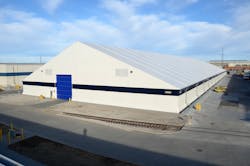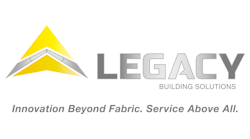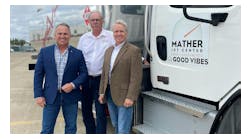We all want “better” – better homes, better schools for our kids, better quality of life all around. Of course, defining what exactly constitutes improvement isn’t always easy. Additionally, it’s proverbially true that the grass isn’t always greener on the other side of the fence… so certain attempts at making something better don’t always yield the desired results.
But when it comes to industrial and commercial building construction, including aircraft hangars and other airport facilities, efforts to bring sustainable design to the forefront have been extremely successful. And for the most part, people agree that the “green” movement is delivering the intended benefits.
Over the years, the concept of sustainability has generally become less about meeting the criteria set forth by LEED (Leadership in Energy and Environmental Design) and actually achieving any official certification. Rather, building owners and operators are far more focused on the practical, day-to-day advantages of green building, such as energy efficiency and the related reduction in operating costs. It is those factors that make sustainability such a high priority when building new structures today.
Natural Green Properties
Aviation-related facilities can get a head start on achieving greater energy efficiency simply through the materials used to construct a building. A popular trend in many industrial applications is to install a building that utilizes a tension fabric roof. Today’s polyethylene (PE) and polyvinyl chloride (PVC) fabrics generally offer very high quality and durability. Furthermore, the natural properties of these materials make them a perfect choice for building users seeking green improvements.
The most important characteristic of (engineered) fabric from a sustainability perspective is that it provides high solar reflectance, which keeps the roof cooler and reduces the overall heat island effect by deflecting sunlight and heat away from the structure. Fabric roofs also absorb less heat due to a high thermal emittance. During the summer months, these material properties contribute to keeping fabric roofs about 50 to 60 Fahrenheit degrees cooler than roofs built using conventional building materials. The end result is a far lesser need for air conditioning or other cooling inside the building.
While an engineered fabric roof reflects UV rays, the light diffusion that does get through the material is highly beneficial. Fabric offers up to 12-percent translucency, allowing natural light to flood the interior of a building and often providing more than enough working light during the daytime.
Direct sunlight produces approximately 10,000 foot-candles of illumination; therefore, even a roof with just 5-percent translucency would still allow around 500 foot-candles to permeate the structure a sunny day. This is still significantly higher than the minimum 75 to 100 foot-candles typically recommended to safely perform maintenance tasks inside an aircraft hangar.
Of course, most airport buildings will still require artificial lighting for nighttime tasks, as well as to provide ample illumination when the sky is stormy or overcast. But those artificial lights are effectively unnecessary during normal daylight hours. Simply by making use of the sun for natural daylighting, fabric roofs help building users take a big step toward lower electric bills and overall energy efficiency.
Sustainable Engineering
While fabric itself has always offered a certain level of sustainability to aircraft hangars and other facilities, the structural aspects of fabric buildings have not always been ideal. Fabric structures traditionally were erected using hollow-tube, open web truss framing. This style was adequate and served various industries well for many years, but eventually it became clear that these structures needed to evolve to become more sturdy and durable. The traditional style was also limited in how well it could accommodate new, green building features.
A key engineering upgrade was introduced several years ago when Legacy Building Solutions incorporated rigid frame engineering into fabric structures. In other words, a fabric roof could now be applied to the structural steel I-beams used in most conventional industrial construction projects. This concept allowed for far more design flexibility when customizing the alignment and overall size of a fabric structure. It also allowed users to request additional features to make the building more operationally and energy efficient.
Solar Panels
The potential energy savings afforded by natural daylight entering a building is great, but actually capturing and creating auxiliary power through the use of solar panels is even better. At a minimum, building operators can reduce their dependence on outside power, and it’s possible to become completely self-sufficient by supplying their own energy.
Where old “hoop” style fabric structures were fairly cheap to produce, rigid frame fabric buildings feature a more common architectural design that gives them significantly more strength. The structural integrity and shape of a well-engineered fabric building will easily support the weight of solar panels right on the roof if desired.
Common solar options include traditional crystalline or silicon panels. Some industry manufacturers have also worked with a thin-filmed photovoltaic that adheres directly to the building’s fabric panels. Another less sophisticated system for solar heating during winter months utilizes perforated metal to capture hot air in a cavity and bring it into a hangar or other structure.
Interior Environment
The design of a rigid frame fabric building also makes it relatively simple to add items such as interior fabric liners and insulation to the roof and sidewalls. Installers can achieve a certain level of temperature control simply by adding a liner to the interior of the fabric. The liner can be combined with insulation material to create more effective insulation values of up to R-40, which meets almost all applicable energy codes.
No matter what level of insulation is or isn’t applied, leading manufacturers are able to provide an airtight building envelope, helping users to save significant costs in heating and cooling.
Structures that demand both insulation and natural light can get the benefits of each by including a fabric skylight in the building design. Certain insulation packages may require covering a fair amount of the building’s translucent fabric. However, it is possible to provide ample illumination by keeping a large section of uninsulated fabric as a skylight, while still applying enough insulation to meet the required energy codes.
Another factor impacting a fabric building’s interior environment is ventilation, which can be addressed through passive or mechanical means. A rigid frame structure can support mounted loads such as fans or heavy-duty ventilators if necessary. Other users often choose to implement a natural gravity ventilation system that relies on the simple movement of hot air.
As warmer air rises, it interacts with pressure intakes around the perimeter of the building at the base and a gravity ventilator at the ridge to effectively create circulation throughout the inside of the structure. By providing a natural intake for fresh air and an evacuation point for fumes without the need for powered equipment, users can further cut down energy consumption and operating costs.
Resources and Results
On top of being naturally energy-efficient, tension fabric aircraft hangars also typically make responsible use of existing resources. The structural steel I-beams in a rigid frame fabric structure contain about 90-percent recycled steel. Other basic accessories can also be applied to the building, such as gutters and downspouts to collect rain runoff into cisterns, providing an additional water source as needed around the facility.
The number of building users and manufacturers who recognize the importance of energy and resource management continues to grow. Thus far it has mainly been a function of economics – by applying logical green building principles, energy usage is reduced and money is saved, plain and simple. The environmental aspect of the equation matters, too, though building operators who need to be wary of the bottom line are understandably slower to adopt new technology for environmental benefits alone.
Whatever the motivation, committing to sustainability makes a lot of sense. The grass may not always be greener on the other side…but with the right approach, your building easily can be.
Ben Fox is president and CEO, Legacy Building Solutions.






